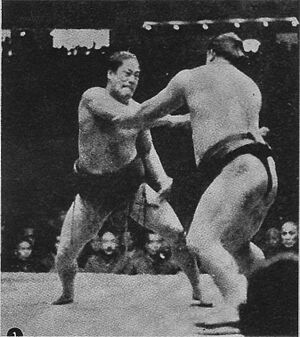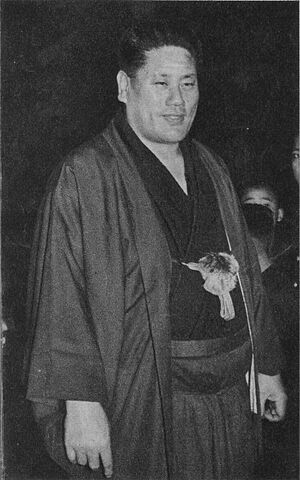Maedayama Eigorō facts for kids
Quick facts for kids Maedayama Eigorō |
|
|---|---|
| 前田山 英五郎 | |

Script error: The function "getImageLegend" does not exist.
|
|
| Personal information | |
| Born | Hagimori Kanematsu May 4, 1914 Ehime, Japan |
| Died | August 17, 1971 (aged 57) |
| Height | 1.80 m (5 ft 11 in) |
| Weight | 116.5 kg (257 lb) |
| Career | |
| Stable | Takasago |
| Record | 306–153–39 |
| Debut | January 1929 |
| Highest rank | Yokozuna (June 1947) |
| Retired | October, 1949 |
| Elder name | Takasago |
| Championships | 1 (Makuuchi) 1 (Jūryō) 1 (Makushita) |
| * Up to date as of June 2020. | |
Maedayama Eigorō (Japanese: 前田山 英五郎, May 4, 1914 – August 17, 1971) was a famous Japanese professional sumo wrestler. He came from Ehime Prefecture and became the 39th yokozuna, which is the highest rank in sumo.
Contents
Maedayama's Early Life and Sumo Start
Maedayama Eigorō was born Hagimori Kanematsu in Nishiuwa District, Ehime. When he was young, in 1926, he met another future yokozuna named Futabayama Sadaji during a school trip. They met again after Maedayama joined the Takasago stable sumo training center in 1927. From then on, he and Futabayama often practiced sumo together.
He started his professional sumo career in January 1929. At first, his ring name, called a shikona, was Yoshigiyama. Later, in May 1930, he changed it to Sadamisaki Eigorō. In January 1935, he changed his surname to Maedayama. He did this to honor a surgeon who helped him continue his sumo career after he was injured and couldn't wrestle for all of 1934.

Rising Through the Ranks
Maedayama reached the top sumo division, called makuuchi, in January 1937. He quickly moved up the ranks. In May 1938, he was promoted to ōzeki, which is the second-highest rank. This was a very fast promotion, as he jumped straight from the fourth-highest rank, komusubi. He became ōzeki after finishing second in a tournament.
In January 1941, Maedayama showed his strength by defeating two top wrestlers: ōzeki Haguroyama and yokozuna Futabayama. His most powerful sumo move was harite, which is a face slap. This move caused some debate, but Futabayama supported him, saying it was a fair sumo technique.
Becoming a Yokozuna
Maedayama was an ōzeki during the war years, when not many sumo tournaments were held. He won his only top division championship in the autumn of 1944, with a great record of 9 wins and 1 loss.
He was promoted to yokozuna in June 1947. He was 33 years old when he reached this highest rank. During his time as yokozuna, he didn't win any more championships. He only managed to get two kachi-koshi (winning records) in tournaments. Maedayama was known for being a strong and sometimes controversial person. In October 1949, the Japan Sumo Association made him retire. This happened after he pulled out of a tournament, saying he was sick, but then he was seen at a baseball game.
Life After Sumo: As a Coach
Even while he was still wrestling, Maedayama became the head coach of Takasago stable in 1941. This is not allowed anymore in sumo. After he retired from wrestling, he officially took on the name Takasago Oyakata, which is a sumo elder name.
As a coach, he helped many wrestlers. In 1964, he brought Takamiyama from Hawaii to Japan. Takamiyama was the first foreign wrestler to become successful in professional sumo. Maedayama also traveled to the United States to promote sumo, even without getting permission from the Sumo Association.
He coached Asashio Tarō III to become a yokozuna in 1959 and Maenoyama Tarō to become an ōzeki in 1970. In 1967, he allowed Chiyonoyama's Kokonoe stable to join his group of stables, called an ichimon. This made the Takasago ichimon stronger.
Maedayama became calmer later in his life. He passed away on August 17, 1971, due to a liver illness. He died before he could see Takamiyama become the first foreign wrestler to win a championship in 1972. After Maedayama's death, other famous foreign wrestlers like ōzeki Konishiki and yokozuna Asashōryū joined his stable.
See also
- Glossary of sumo terms
- List of past sumo wrestlers
- List of sumo tournament top division champions
- List of yokozuna


